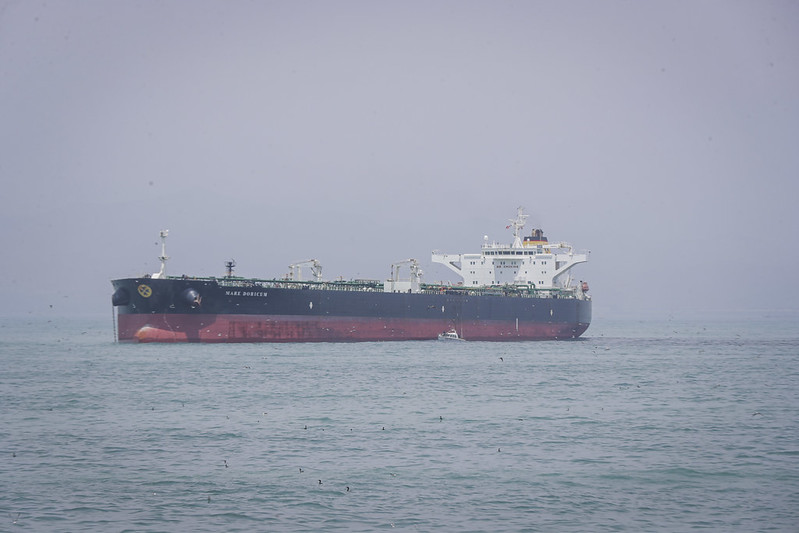The flora and fauna of protected areas in Peru are in danger after an oil spill occurred during the unloading process of the Italian flagged vessel Mare Doricum. The Peruvian government declared an environmental emergency for 90 days and established a schedule for the oil company Repsol to comply with clean-up tasks in the short term.
Catástrofe Ecológica sin precedentes en #Perú: Derrame de Petróleo responsable de empresas Repsol contamina al menos 18 mil kilómetros de zona protegida en Ventanilla, Santa Rosa, Ancón y Chancay, Lima. (18.01.2022). Decenas de animales han muerto. https://t.co/fkL2BklUWo
— ⚠️Alerta Climagram🌎 (@deZabedrosky) January 20, 2022
The spill was initially estimated to have been seven gallons according to information provided by the company. At first, Repsol described the spill as limited, assuring people that they had contained the emergency with their contingency plan. Later, information provided by the Ministry of the Environment revealed that the spill was actually 6,000 barrels of crude oil. The underestimation of the damage delayed the work.
The spill, which occurred on January 15 at the La Pampilla refinery in the province of Callao, has extended hundreds of kilometers, affecting 17 beaches. Dozens of animals have died in these natural areas and national reserves. According to data from the Environmental Assessment and Control Agency, the damaged area is 1,739,000 square meters, so far.
Different versions of events
According to Repsol spokespersons, the spill was caused by the strong waves resulting from the volcanic eruption in Tonga. The Spanish company stated that the tanker that was unloading crude oil was rocked by the waves, causing the rupture of the underwater pipeline, however, they allege that the crew acted in time when the spill occurred.
An oil spill off the coast of Peru is devastating the marine ecosystem and beaches. Take a look.pic.twitter.com/Yb3ApAEhXN
— Steve Hanke (@steve_hanke) January 22, 2022
They also blamed the Peruvian maritime authorities who did not send a tsunami warning to the country, while other neighboring nations, such as Chile, did. For its part, the Peruvian government expects the company to take responsibility and compensate the country for the damage caused.
Although Repsol claims that they did not cause the ecological disaster, some experts on the subject have indicated that these companies should be prepared for emergency procedures and impact studies. They also consider that the damage could have been avoided if the alarm had been raised in time. Timely information on the exact amount of the spill could have prevented the extent of the damage as the days went by.
The prosecutor’s office initiated an investigation to determine responsibility for the crime of environmental contamination, a disaster that could generate damage for up to a decade. The fines for the refinery could amount to US$34.5 million.
The impact on natural resources
The impact of the spill is significant on hydrobiological resources and wildlife. According to the National Service of Natural Areas Protected by the State, the spill moved north due to marine currents, resulting in an increase in the affected area. This displacement puts at risk a greater number of species that live in the region.
Drone footage showed black sludge covering Peru’s golden beach following an oil spill on January 16 caused by Tonga’s volcanic eruption. The sludge, from a discharge ship rocked by unusually high waves, contaminated at least 1.2 miles along the coast and two beaches. pic.twitter.com/qwnvjPkcGL
— NowThis Impact (@nowthisimpact) January 21, 2022
The threat also looms over two protected marine reserves, where Humboldt penguins, sea otters, seagulls and gray cormorants find refuge. The first images of the environmental disaster show rescuers trying to save the lives of the affected animals, some of them can be treated in time, others cannot. Many of the rescued creatures are covered in oil and need special treatment for their recovery.
There is additionally a high public health risk, as the zone is commonly used by fishermen, so it is estimated that contaminated food may have reached the markets. Meanwhile, hundreds of fishermen have lost their jobs as a result of the environmental emergency, and commercial establishments that depend on tourism had to close.
The removal works
A few days after the spill, Repsol’s clean-up crews (1,350 people) had removed more than 2,000 cubic meters of sand. In addition, 90 pieces of machinery have been used including 13 large vessels, 7 marine cleaning machines, 46 heavy vehicles on land, 3 recovery tanks and 6 floating tanks. As well, 2,500 meters of containment barrier were installed.
🇵🇪 | Ventanilla en Perú tras el derrame de petróleo en el agua: pic.twitter.com/g9DXp75LXY
— Alerta News 24 (@AlertaNews24) January 19, 2022
However, some local residents and experts who have visited the area have complained that the cleanup groups are smaller than expected and that the equipment used is inadequate.
It is estimated that the recovery work in the affected area could be completed by the end of February. Repsol, for its part, stated in a press release that it is committed to responding effectively. One of the priorities is with the fishermen from the area, with whom they have already communicated, however, these groups are unsatisfied with the situation and have protested in recent days.
Image credit: Ministerio de Defensa del Perú

